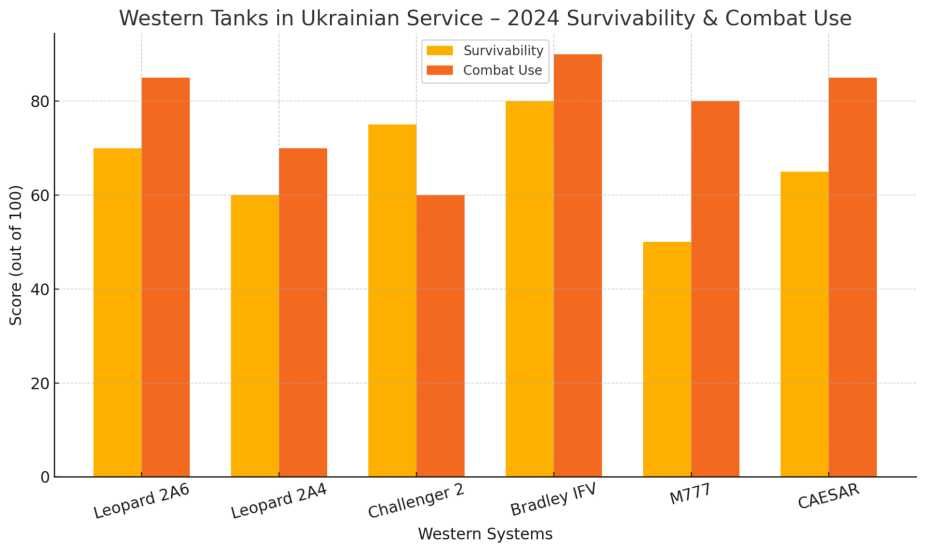Breaking News
Exclusive Analysis: How Western and Russian Combat Equipment Are Performing in Ukraine’s 2024 Counteroffensives.
Now in its third year, the war in Ukraine has become the most extensive proving ground for modern military equipment since World War II. The 2024 campaigns have intensified this dynamic, transforming the battlefield into a high-stakes arena where Western-supplied tanks, precision artillery, and advanced drones confront Russian loitering munitions, electronic warfare, and legacy armor. Both sides are drawing hard lessons in real time, as their most sophisticated systems are tested under relentless, often unforgiving combat conditions.
Follow Army Recognition on Google News at this link

Three US Bradley IFVs, a Leopard 2A6 tank and a BMR-2 armored demining equipment were destroyed by the Russian army in Zaporizhzhia Oblast, June 2023. (Picture source: Social Network)
On the Ukrainian side, the German-made Leopard 2A6 main battle tanks have seen extensive use in attempts to break through Russian defensive lines. One dramatic example includes footage verified by open-source intelligence channels like @UAWeapons, showing a Leopard 2A6 disabled by a mine strike and subsequently hit by a loitering drone. The stills of that incident, shared across social media, highlight both the platform’s combat presence and its vulnerability in mine-laden terrain. YouTube footage showing Leopard units rolling through contested areas in Zaporizhzhia has also gone viral, providing a rare close-up look at modern armored warfare in action.
Ukrainian forces have also embraced the Bradley M2A2 ODS infantry fighting vehicle, particularly for infantry support and medical evacuation under fire. Several videos have shown Bradleys absorbing RPG hits and continuing to move, often pulling back wounded crew members to safety. These moments have underscored the vehicle’s survivability, especially when compared with legacy BMP variants. Images of Bradleys operating in muddy terrain, accompanied by drone overwatch, have been shared widely, giving a visceral sense of the modern mechanized battlefield.
Artillery systems like the U.S. M777 155mm towed howitzer and the CAESAR 155mm truck-mounted gun have delivered precise, high-impact fire support. Ukrainian gunners have used these NATO-supplied assets to great effect, especially in fast repositioning after fire missions to avoid Russian counter-battery attacks. However, drone footage from Russian sources has also revealed several cases where unprotected M777s were destroyed by Lancet drones, reinforcing the need for constant movement and anti-drone overwatch.

Comparative performance of Western-supplied armored systems in Ukraine’s 2024 counteroffensive, highlighting survivability and combat effectiveness based on verified battlefield data. (Picture source Army Recognition Group)
To complement this analysis, an infographic titled “Western Tanks in Ukrainian Service – 2024 Survivability & Combat Use” could visualize statistics on kill rates, mobility performance, and battlefield loss data. This would include platforms like the German Leopard 2A6 tank, British Challenger 2, U.S. Bradley M2A2 IFV (Infantry Fighting Vehicle), and French CAESAR 155mm self-propelled howitzer, offering a concise snapshot of combat value and vulnerability.
On the Russian side, the T-90M Proryv remains its most capable deployed tank. While video from early 2024 showed it performing well in static defense roles and urban engagements, more recent footage depicts multiple T-90Ms falling victim to Western top-attack ATGMs such as Javelins and NLAWs. Thermal camera footage from Ukrainian drone operators has captured these moments with haunting clarity, often showing the vulnerable turret roof penetrated in seconds. The T-80BVM, with its high mobility, has been favored in harsh winter conditions, but its survivability under drone attack appears similarly compromised.
Russia’s use of loitering munitions — most notably the Lancet drone — has been especially aggressive. Dozens of videos document Lancets diving into howitzers, air defense systems, and stationary armored vehicles. These clips, widely circulated across platforms like Telegram and YouTube, illustrate just how much the airspace just above the tree line has become the deadliest layer of the battlefield. Alongside these systems, Russia is deploying vast numbers of low-cost FPV drones equipped with improvised warheads, allowing for precise strikes on vulnerable rear positions and moving vehicles.
Ukraine has responded by integrating its own drone tactics, often crowdfunding FPV drone units that are now embedded within every mechanized and infantry battalion. The role of commercial drones repurposed for combat is also growing. Video compilations now show Ukrainian FPVs chasing down Russian supply vehicles or dropping grenades on bunkers, often edited and posted just hours after the mission.
An expert assessment of battlefield kill vectors shows that loitering drones now account for 34% of vehicle losses, followed by ATGMs at 26%, mines and IEDs at 20%, and traditional artillery at 12%. This shift could be visualized through a pie-chart infographic, giving readers a quick breakdown of what weapon types are doing the most damage.
Commentary from retired military officers supports the notion that modern survivability no longer comes from armor thickness alone. As retired Ukrainian Colonel Viktor Shendruk explains, “A $500 FPV drone can destroy a $5 million tank if it’s not supported by infantry, EW coverage, and layered defense.”
Concluding this battlefield snapshot, side-by-side visuals of destroyed Leopard 2s and T-90Ms, next to drone footage from both sides, illustrate that no system — no matter how modern — is immune in this new era of precision-guided warfare. In the coming months, new equipment like the M1A1 Abrams, K9 Thunder, and NASAMS will face the same frontline tests, as Ukraine and Russia both continue to adapt in this high-tech arms race.
In our next analysis, we’ll move from land to sea, examining how naval drones and advanced air defense systems are shaping the battles in the Red Sea — stay tuned for our tactical breakdown of Red Sea naval drone warfare.


























